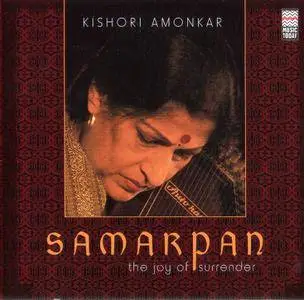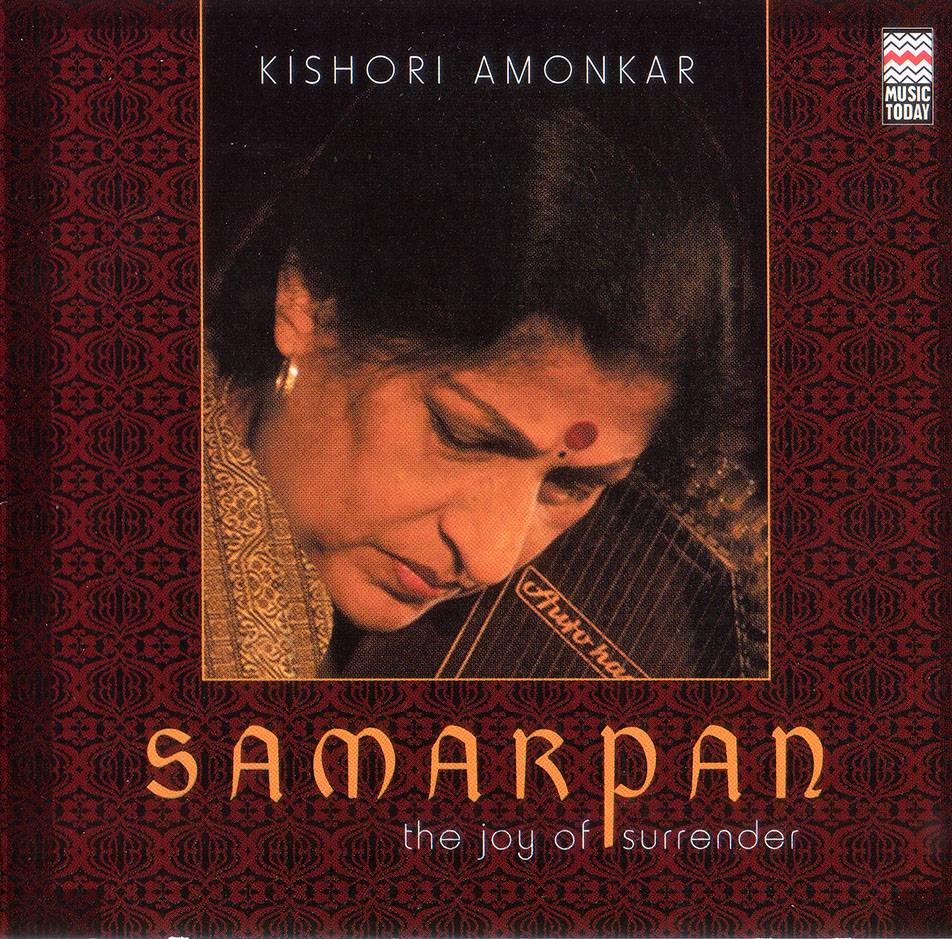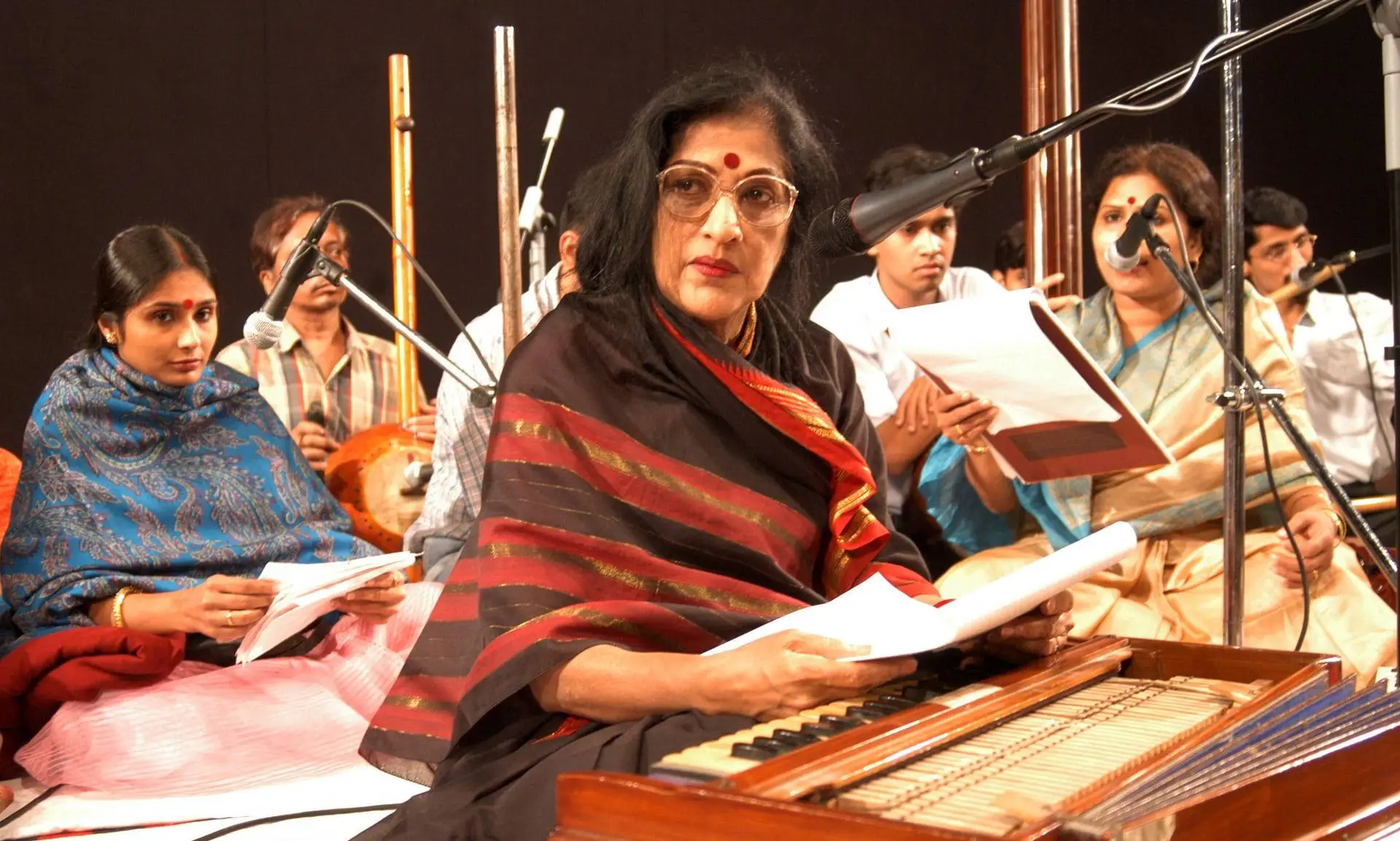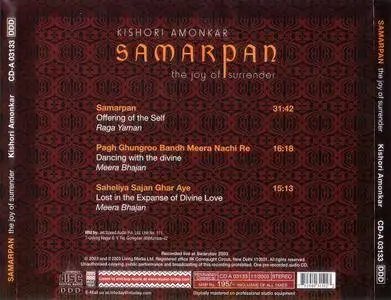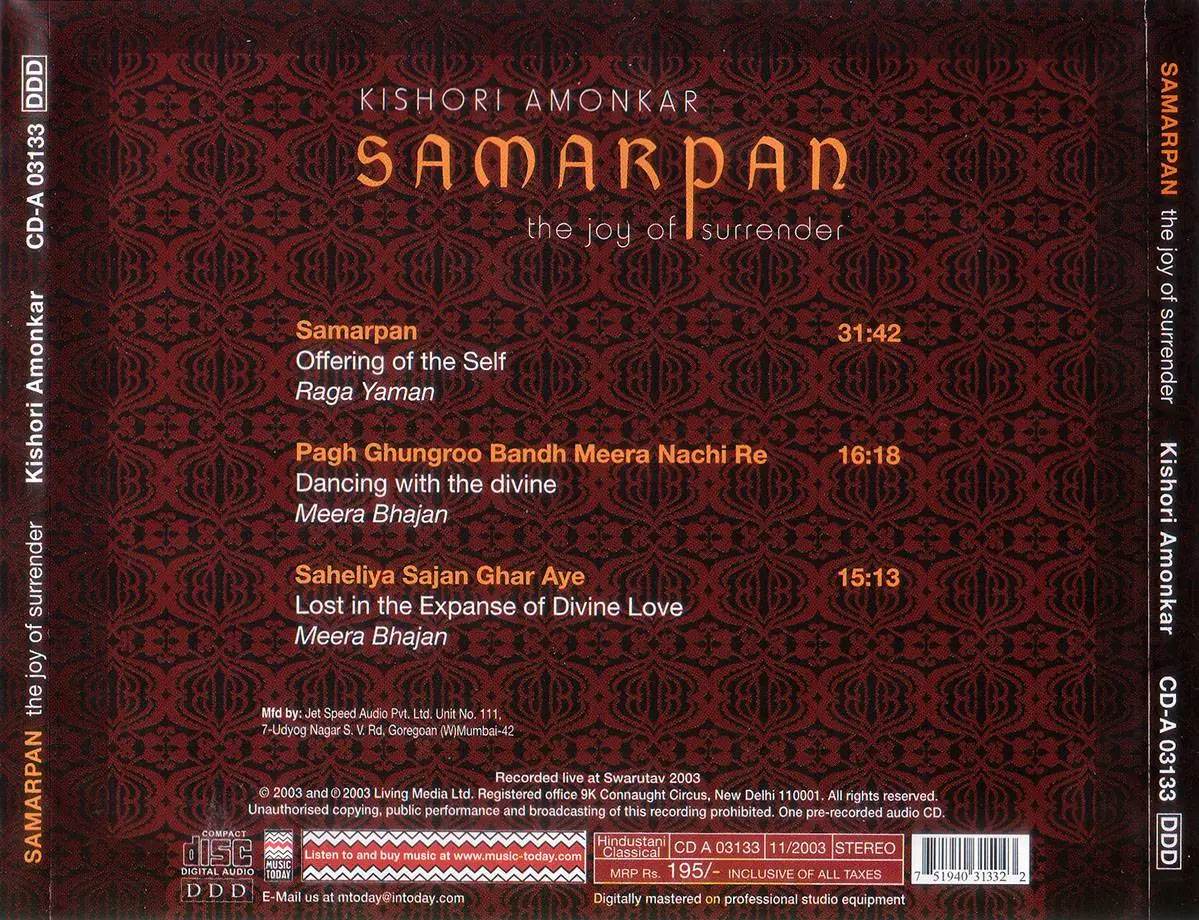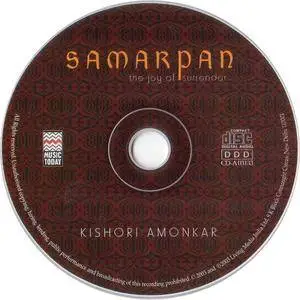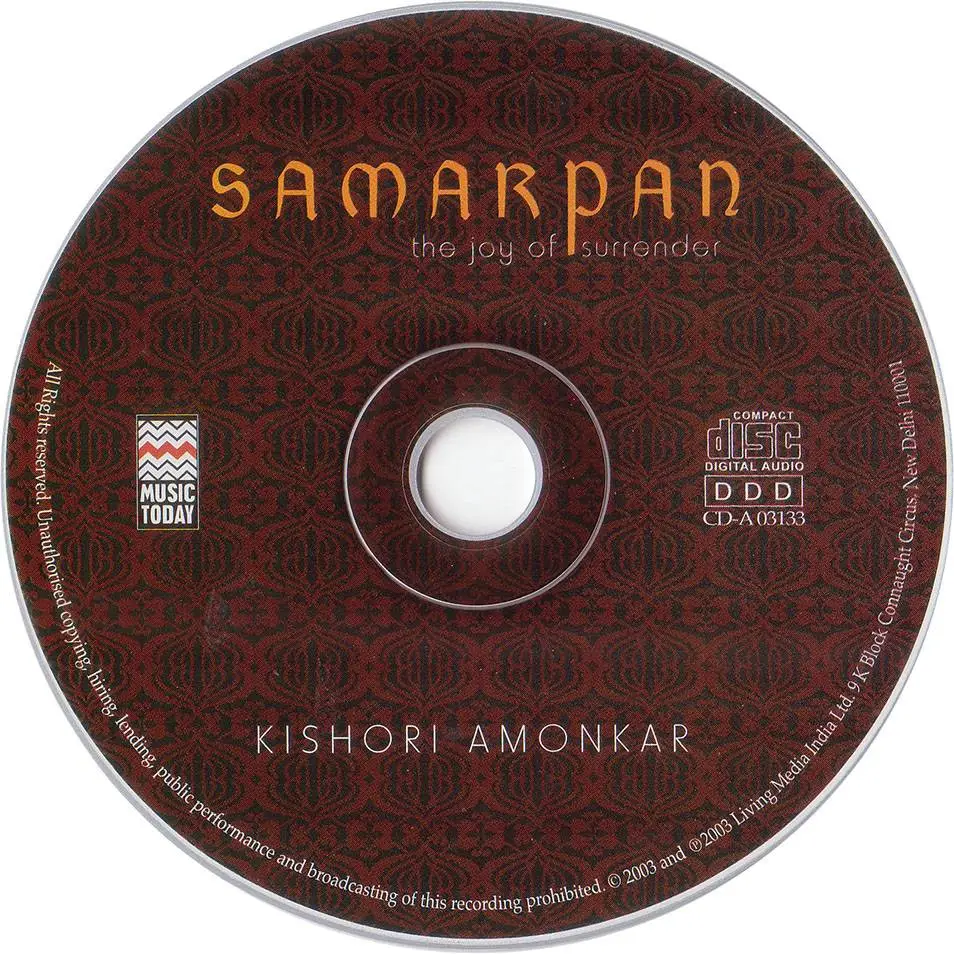Kishori Amonkar - Samarpan: The Joy Of Surrender (2003)
EAC | FLAC | Tracks (Cue&Log) ~ 360 Mb | Mp3 (CBR320) ~ 166 Mb | Scans included | 01:03:17
Indian Classical, Hindustani Music, Raga | Label: Music Today/Living Media | # CD-A 03133
EAC | FLAC | Tracks (Cue&Log) ~ 360 Mb | Mp3 (CBR320) ~ 166 Mb | Scans included | 01:03:17
Indian Classical, Hindustani Music, Raga | Label: Music Today/Living Media | # CD-A 03133
This album is a unique offering from the inimitable Kishori Amonkar. To survive is an animal instinct. To conquer is a base human desire. Samarpan or to surrender is the first act of being truly human, the first footstep towards attaining the divine. Surrender is not supplication. Surrender is the act of freeing oneself from the trap of the human design. To surrender is to let go of the belief that I am on my own, and I am my only protector. To surrender is to dive into the ocean of conviction that life is a divine design, and I can play in that pool of divine love like a child.
Kishori Amonkar presents four aspects of Surrender to the Divine.
Samarpan (Raga Yaman) : Kishori Amonkar opines that the term 'Yaman' has been adapted from 'Samarpan' or surrender. Her interpretation of this most beautiful and expansive of ragas is one of the most arresting ever heard. Her own vilambit composition is a perfect lyrical mould for the ethos of Yaman. "Sakhi Eri Ali Piya Bina", the drut is rendered with a softness concomitant with the act of surrender. Within this mood, of course, the mastermind of classicism fires her typical taan-s, swirling through the saptak-s with Elan.
Surrender is the first step to true living - the first door to the world of genuine joy. Surrender opens up a world of immense brightness, serenity, peace and happiness.
Dancing with the Divine - "Paga Ghunghroo Bandh Meera Nachi Re" is one of the most popular of the saint singer's bhajan. In Kishori Amonkar's rendition, the composition pirouettes like Meera herself would have, dancing in complete ecstasy, unconscious of surroundings and people, lost in her Lord.
Lost in the Expanse of Divine Love - "Saheliya Sajan Ghar Aye" is set to the beautiful raga Mand. Mand is a raga drawn from the Mand genre of Rajasthan, the janmabhoomi of saint Meera. The raga, as in the original form, has a colour of expansive openness, longing and intense desire, seeking the eternal sajan - Krishna.
About Kishori Amonkar (10 April 1931 – 3 April 2017):
Kishori Amonkar, was one of Hindustani music’s finest classical singers. A specialist in the khyal style, which emphasises emotion and improvisation, she was known for her rich, soulful voice and for combining innovation with tradition; she also mixed her classical work with an interest in popular songs and film music. India’s president, Pranab Mukherjee, said that her death was “an irreparable loss to the world of Indian music”.
Although recognised as a leading exponent of the Jaipur gharana (a community of musicians who share a distinctive style), she developed an individual approach that reflected other gharanas – which brought her criticism as well as praise. She argued that “one should not teach students the limits of this art … There are none. But one has to understand the grammar – that is why one is taught the ragas.” She became known for the ease of her singing, and for what one Indian writer described as her “painful melancholy”.
Kishori was born in what was then Bombay, now Mumbai. Her father, Madhavdas Bhatia, died when she was six, leaving her and her two siblings to be brought up by their mother, Mogubai Kurdikar, a celebrated classical singer who had a profound influence on her career. Mogubai had been taught by Alladiya Khan, founder of the Jaipur gharana, and passed on these vocal techniques to her daughter. She was an exacting teacher: Kishori said that her mother would sing her a sthayi (a phrase or line of a Hindustani composition) just twice, and she was expected to concentrate so hard that she learned and understood the song in that short time.
In her early career Amonkar travelled with her mother to performances, accompanying her on the tanpura, the stringed instrument used to provide drone effects. While working with her mother, and watching her perform, she became concerned at the way that female classical musicians were treated, in particular that they were not always fairly paid.
In her 20s, Amonkar reportedly lost her voice completely for two years, and only began singing again after being treated with Ayurveda, traditional Indian medical techniques. She said that the break helped her to develop her individual style, rather than copy what she had been taught.
After establishing her reputation as a classical singer, Amonkar – Tai, as she became affectionately known – was attracted to film music, singing the title song for the 1964 blockbuster Geet Gaaya Pattharon Ne, apparently to the disapproval of her mother, who wanted her to concentrate on classical styles. Even so, she returned to film music later in her career, composing songs for the 1990 movie Drishti.
Although one of India’s finest singers, she never sought international fame. She was notoriously hard to interview, did not enjoy travelling abroad and limited the number of concerts she gave. She did not like to perform more than once a week, even at the height of her career, preferring to stay in her music room, bent over the harp-like swaramandal with which she accompanied her singing. Her riyaaz (rigorous music practice sessions) sometimes lasted for eight to 10 hours a day. Before concerts, she often spent time alone rather than socialising with other musicians.
Famous for chastising audiences if she felt that they were not paying enough attention, on one occasion she refused to perform because she considered the audience to be not suitably respectful. She was quoted as saying that “music is not just about words and beats. It is also about the emotion behind the rendition.” And that “music is a dialogue with the divine”. Her many recordings included Live in London (1998) and Sampradaya: Carrying Forward a Tradition (2003).
She received two of the Indian government’s highest civilian awards. In 1987 she was awarded the Padma Bhushan, which had also been awarded to her mother, and this was followed in 2002 by the Padma Vibhushan. In 2011 she was the subject of a documentary, Bhinna Shadja, in which the tabla virtuoso Zakir Hussain argued that she was one of the greatest Hindustani singers of all time.Robin Denselow, The Guardian
Accompanists
Nandini Bedekar and Sanghamitra Bagchi - Vocals & Tanpura,
Milind Raikar - Violin, Mahesh Kumar - Harmonium,
Pradeep Dikshit - Pakhawa], Balkrishna Iyer - Tabla
Recorded live by Deepak Samson and Pratik Biswas on 17th October 2003 at India Today Swarutsav, New Delhi.
Tracklist:
01. Samarpan (Offering of the Self ) - Raga Yaman (31:44)
02. Pagh Ghungroo Bandh Meera Lachi Re (Dancing with the Divine) - Meera Bhajan (16:19)
03. Saheliya SajanGhar Aye (Lost in the Expanse of Divine Love) - Meera Bhajan (15:14)
Exact Audio Copy V0.99 prebeta 4 from 23. January 2008
EAC extraction logfile from 23. April 2009, 18:46
Kishori Amonkar / Samarpan
Used drive : SONY DVD-ROM DDU1612 Adapter: 2 ID: 0
Read mode : Secure
Utilize accurate stream : Yes
Defeat audio cache : Yes
Make use of C2 pointers : No
Read offset correction : 12
Overread into Lead-In and Lead-Out : No
Fill up missing offset samples with silence : Yes
Delete leading and trailing silent blocks : No
Null samples used in CRC calculations : Yes
Used interface : Installed external ASPI interface
Gap handling : Appended to previous track
Used output format : User Defined Encoder
Selected bitrate : 320 kBit/s
Quality : High
Add ID3 tag : No
Command line compressor : C:\Program Files\Exact Audio Copy0.99pb4\flac.exe
Additional command line options : -8 -V -T "ARTIST=%a" -T "TITLE=%t" -T "ALBUM=%g" -T "DATE=%y" -T "TRACKNUMBER=%n" -T "TOTALTRACKS=%x" -T "GENRE=%m" -T "ALBUMARTIST=%v" -T "ALBUM ARTIST=%v" -T "COMMENT=EAC, FLAC -8" %s
TOC of the extracted CD
Track | Start | Length | Start sector | End sector
––––––––––––––––––––––––––––-
1 | 0:00.01 | 31:43.65 | 1 | 142790
2 | 31:43.66 | 16:19.12 | 142791 | 216227
3 | 48:03.03 | 15:13.58 | 216228 | 284760
Track 1
Filename I:\MusicIndianClassical\Kishori Amonkar - Samarpan (2003) [FLAC]\01 - Samarpan (Offering of the Self ) - Raga Yaman.wav
Pre-gap length 0:00:02.01
Peak level 100.0 %
Track quality 99.9 %
Test CRC 542EF848
Copy CRC 542EF848
Track not present in AccurateRip database
Copy OK
Track 2
Filename I:\MusicIndianClassical\Kishori Amonkar - Samarpan (2003) [FLAC]\02 - Pagh Ghungroo Bandh Meera Lachi Re (Dancing with the Divine) - Meera Bhajan.wav
Peak level 100.0 %
Track quality 99.9 %
Test CRC 574FCA3B
Copy CRC 574FCA3B
Track not present in AccurateRip database
Copy OK
Track 3
Filename I:\MusicIndianClassical\Kishori Amonkar - Samarpan (2003) [FLAC]\03 - Saheliya SajanGhar Aye (Lost in the Expanse of Divine Love) - Meera Bhajan.wav
Peak level 100.0 %
Track quality 99.9 %
Test CRC 45A517A9
Copy CRC 45A517A9
Track not present in AccurateRip database
Copy OK
None of the tracks are present in the AccurateRip database
No errors occurred
End of status report
EAC extraction logfile from 23. April 2009, 18:46
Kishori Amonkar / Samarpan
Used drive : SONY DVD-ROM DDU1612 Adapter: 2 ID: 0
Read mode : Secure
Utilize accurate stream : Yes
Defeat audio cache : Yes
Make use of C2 pointers : No
Read offset correction : 12
Overread into Lead-In and Lead-Out : No
Fill up missing offset samples with silence : Yes
Delete leading and trailing silent blocks : No
Null samples used in CRC calculations : Yes
Used interface : Installed external ASPI interface
Gap handling : Appended to previous track
Used output format : User Defined Encoder
Selected bitrate : 320 kBit/s
Quality : High
Add ID3 tag : No
Command line compressor : C:\Program Files\Exact Audio Copy0.99pb4\flac.exe
Additional command line options : -8 -V -T "ARTIST=%a" -T "TITLE=%t" -T "ALBUM=%g" -T "DATE=%y" -T "TRACKNUMBER=%n" -T "TOTALTRACKS=%x" -T "GENRE=%m" -T "ALBUMARTIST=%v" -T "ALBUM ARTIST=%v" -T "COMMENT=EAC, FLAC -8" %s
TOC of the extracted CD
Track | Start | Length | Start sector | End sector
––––––––––––––––––––––––––––-
1 | 0:00.01 | 31:43.65 | 1 | 142790
2 | 31:43.66 | 16:19.12 | 142791 | 216227
3 | 48:03.03 | 15:13.58 | 216228 | 284760
Track 1
Filename I:\MusicIndianClassical\Kishori Amonkar - Samarpan (2003) [FLAC]\01 - Samarpan (Offering of the Self ) - Raga Yaman.wav
Pre-gap length 0:00:02.01
Peak level 100.0 %
Track quality 99.9 %
Test CRC 542EF848
Copy CRC 542EF848
Track not present in AccurateRip database
Copy OK
Track 2
Filename I:\MusicIndianClassical\Kishori Amonkar - Samarpan (2003) [FLAC]\02 - Pagh Ghungroo Bandh Meera Lachi Re (Dancing with the Divine) - Meera Bhajan.wav
Peak level 100.0 %
Track quality 99.9 %
Test CRC 574FCA3B
Copy CRC 574FCA3B
Track not present in AccurateRip database
Copy OK
Track 3
Filename I:\MusicIndianClassical\Kishori Amonkar - Samarpan (2003) [FLAC]\03 - Saheliya SajanGhar Aye (Lost in the Expanse of Divine Love) - Meera Bhajan.wav
Peak level 100.0 %
Track quality 99.9 %
Test CRC 45A517A9
Copy CRC 45A517A9
Track not present in AccurateRip database
Copy OK
None of the tracks are present in the AccurateRip database
No errors occurred
End of status report
[CUETools log; Date: 12.04.2018 5:41:44; Version: 2.1.4]
Pregap length 00:00:01.
[CTDB TOCID: obCcXGGYBHLBOSnF8gQPULISwoM-] found.
Track | CTDB Status
1 | (1/1) Accurately ripped
2 | (1/1) Accurately ripped
3 | (1/1) Accurately ripped
[AccurateRip ID: 0009d2c5-001fa2df-280ed403] found.
Track [ CRC | V2 ] Status
01 [4b7a2e7b|28dd948e] (0+2/2) Accurately ripped
02 [90204ec1|c6ec1e4e] (0+2/2) Accurately ripped
03 [74573ac8|2e5e9d62] (0+2/2) Accurately ripped
Track Peak [ CRC32 ] [W/O NULL] [ LOG ]
– 100,0 [D6A0805D] [531AEA62]
01 100,0 [542EF848] [23199DB4] CRC32
02 100,0 [574FCA3B] [7EC7443E] CRC32
03 100,0 [45A517A9] [F44D7070] CRC32
Pregap length 00:00:01.
[CTDB TOCID: obCcXGGYBHLBOSnF8gQPULISwoM-] found.
Track | CTDB Status
1 | (1/1) Accurately ripped
2 | (1/1) Accurately ripped
3 | (1/1) Accurately ripped
[AccurateRip ID: 0009d2c5-001fa2df-280ed403] found.
Track [ CRC | V2 ] Status
01 [4b7a2e7b|28dd948e] (0+2/2) Accurately ripped
02 [90204ec1|c6ec1e4e] (0+2/2) Accurately ripped
03 [74573ac8|2e5e9d62] (0+2/2) Accurately ripped
Track Peak [ CRC32 ] [W/O NULL] [ LOG ]
– 100,0 [D6A0805D] [531AEA62]
01 100,0 [542EF848] [23199DB4] CRC32
02 100,0 [574FCA3B] [7EC7443E] CRC32
03 100,0 [45A517A9] [F44D7070] CRC32
foobar2000 1.2 / Dynamic Range Meter 1.1.1
log date: 2018-04-12 05:31:46
––––––––––––––––––––––––––––––––––––––––
Analyzed: Kishori Amonkar / Samarpan
––––––––––––––––––––––––––––––––––––––––
DR Peak RMS Duration Track
––––––––––––––––––––––––––––––––––––––––
DR14 0.00 dB -17.32 dB 31:44 01-Samarpan (Offering of the Self ) - Raga Yaman
DR12 0.00 dB -14.30 dB 16:19 02-Pagh Ghungroo Bandh Meera Lachi Re (Dancing with the Divine) - Meera Bhajan
DR12 0.00 dB -13.59 dB 15:14 03-Saheliya SajanGhar Aye (Lost in the Expanse of Divine Love) - Meera Bhajan
––––––––––––––––––––––––––––––––––––––––
Number of tracks: 3
Official DR value: DR13
Samplerate: 44100 Hz
Channels: 2
Bits per sample: 16
Bitrate: 756 kbps
Codec: FLAC
================================================================================
log date: 2018-04-12 05:31:46
––––––––––––––––––––––––––––––––––––––––
Analyzed: Kishori Amonkar / Samarpan
––––––––––––––––––––––––––––––––––––––––
DR Peak RMS Duration Track
––––––––––––––––––––––––––––––––––––––––
DR14 0.00 dB -17.32 dB 31:44 01-Samarpan (Offering of the Self ) - Raga Yaman
DR12 0.00 dB -14.30 dB 16:19 02-Pagh Ghungroo Bandh Meera Lachi Re (Dancing with the Divine) - Meera Bhajan
DR12 0.00 dB -13.59 dB 15:14 03-Saheliya SajanGhar Aye (Lost in the Expanse of Divine Love) - Meera Bhajan
––––––––––––––––––––––––––––––––––––––––
Number of tracks: 3
Official DR value: DR13
Samplerate: 44100 Hz
Channels: 2
Bits per sample: 16
Bitrate: 756 kbps
Codec: FLAC
================================================================================


